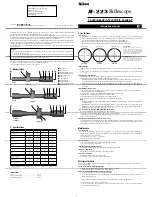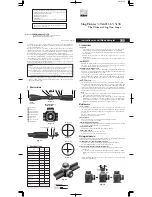
10
Try using different optional eyepieces to see how the field changes with various
magnifications.
WARNING !
NEVER POINT YOUR TELESCOPE AT THE SUN UNLESS YOU HAVE THE
PROPER MYLAR SOLAR FILTER. PERMANENT AND IRREVERSIBLE EYE
DAMAGE MAY RESULT AS WELL AS DAMAGE TO YOUR TELESCOPE.
ALSO, NEVER LEAVE YOUR TELESCOPE UNATTENDED DURING A
DAYTIME OBSERVING SESSION, ESPECIALLY WHEN CHILDREN ARE
PRESENT.
Although overlooked by many amateur astronomers, solar observation is both
rewarding and fun. However, because the Sun is so bright, special precautions
must be taken when observing our star so as not to damage your eyes or your
telescope.
WARNING!
Never project an image of the Sun through the telescope. Tremendous
heat build-up near the back of the telescope can damage any accesso-
ries attached to the telescope.
Use a Celestron mylar solar filter to view the Sun in complete safety. These
filters reduce the intensity of the Sun’s light making it safe to view. With these
filters you can see sunspots as they move across the solar disk and faculae,
which are bright patches seen near the Sun’s edge. Be sure to cover the
lens of the finder when observing the Sun. This will ensure that the
finder is not damaged and that no one looks through it accidentally.
In the night sky, the Moon is a prime target for your first look because it is
extremely bright. Often, it is a temptation to look at the Moon when it is full.
At this time, the face we see is fully illuminated and its light can be overpower-
ing. In addition, little or no contrast can be seen at this time.
One of the best times to observe the Moon is during its partial phases (around
the time of first or third quarter). Long shadows reveal a great amount of detail
on the lunar surface. At low power you will be able to see the entire lunar disk
at one time. Change to higher power (magnification) to focus in on a smaller
area. Keep in mind that the rotation of the Earth will cause the Moon to drift
out of your field of view. You will have to manually adjust the telescope to keep
the Moon centered. This effect is more noticeable at higher power. Consult
your local newspaper or current astronomy magazine to find out when the
Moon is visible.
This same method can be used to observe the planets. You can see Venus
go through its lunar-like phases. Mars will reveal a host of surface detail and
one, if not both, of its polar caps. You will be able to see the cloud belts of
Jupiter and the great Red Spot. In addition, you will also be able to see the
Moons of Jupiter as they orbit this gas giant. Saturn with its beautiful rings is
easily visible at moderate power. All you need to know is where to look. Most
astronomy publications tell where the planets can be found in the sky each
month.
Deep-sky objects are simply those objects outside the boundaries of our solar
system. They include star clusters, planetary nebulae, diffuse nebulae, double
stars and other galaxies outside our own Milky Way. The Celestron Sky Maps
(#93722) can help you locate the brightest deep-sky objects. You can “star
hop” to an object from an area with which you are familiar.
Observing the Sun,
Moon, and Planets
Observing Deep-Sky
Objects





























